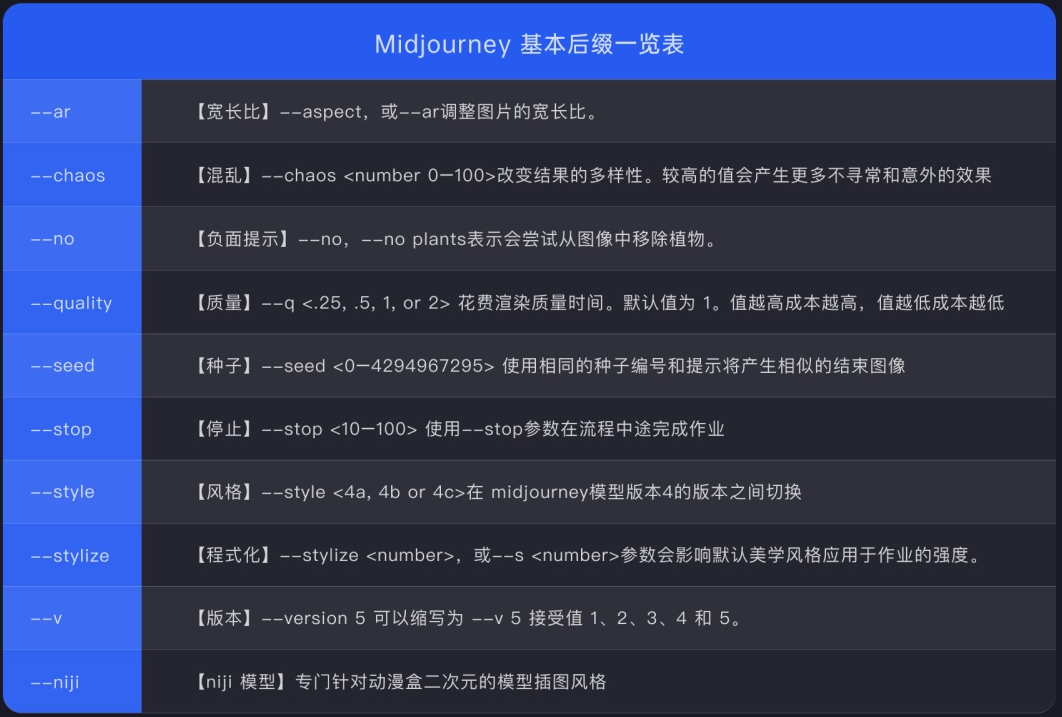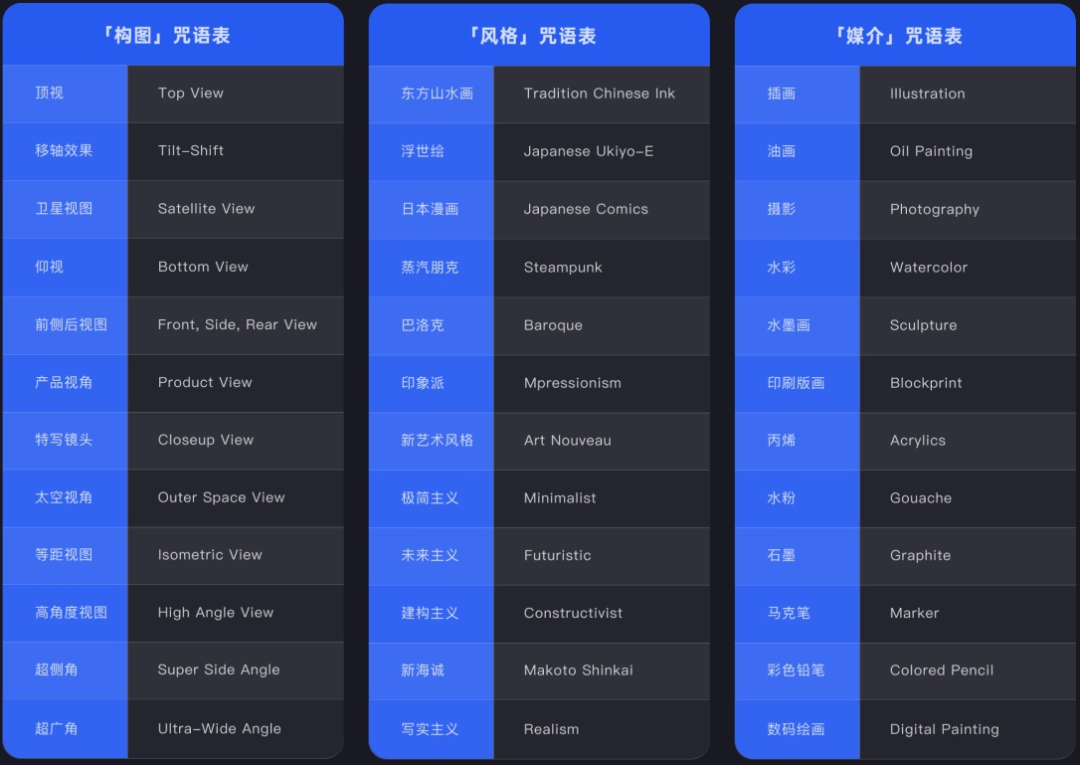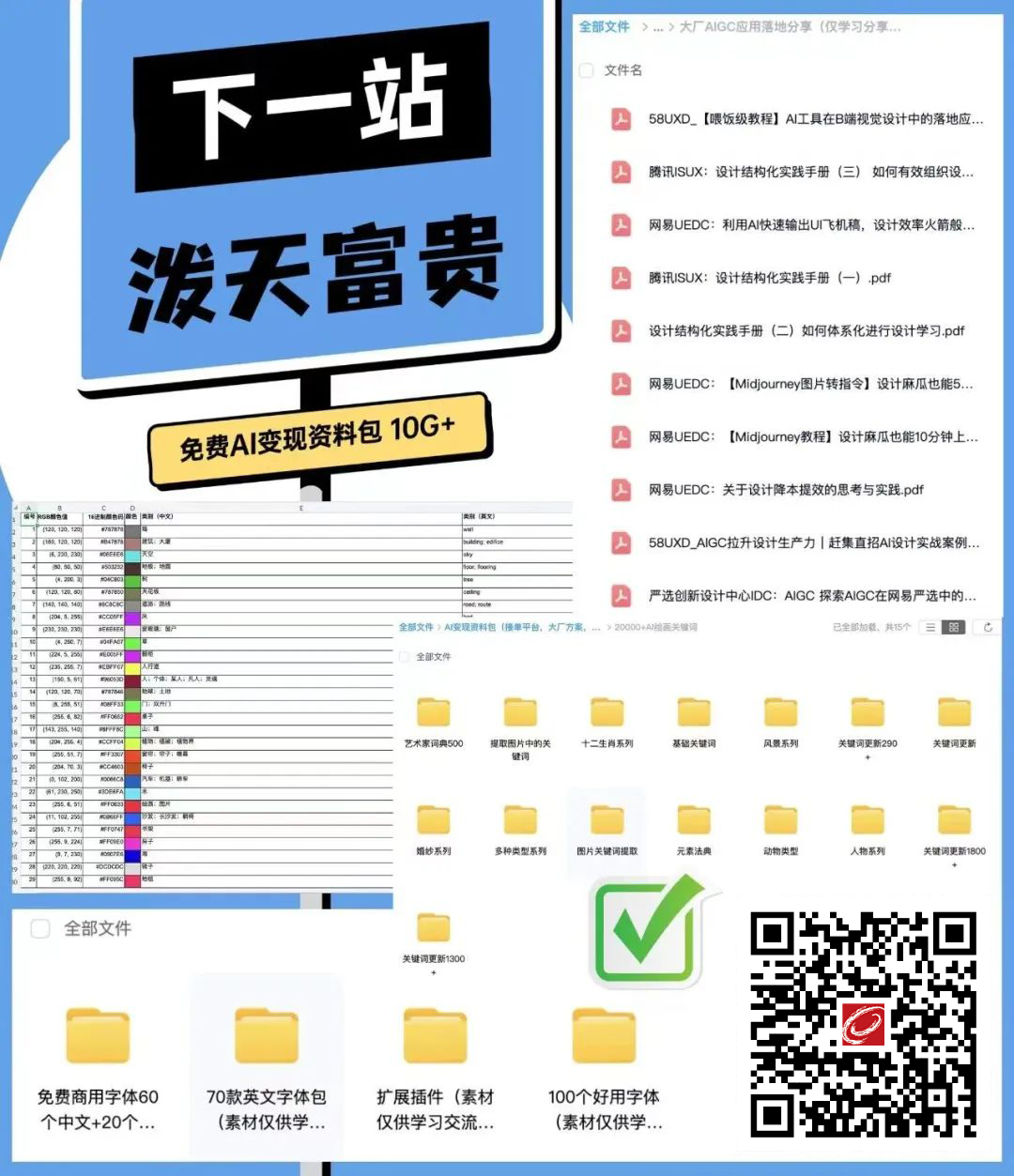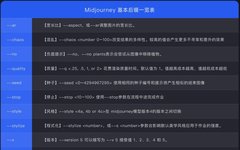Midjourney Basic Parameters

/imagine “prompt” is the most basic text-to-image command; entering prompts after it will generate images.
/describe “image” is the latest image-to-text command; upload an image, and it will generate four descriptive phrases.
/settings is used to configure modes, including model version, style value, quality value, and upscaler version.
/subscribe is a link to purchase membership services and manage subscriptions.
/ask “question” gets answers to questions.
/blend is a blending mode that allows you to upload 2-5 images and then combine them into a new image effect.
/info checks your user information, including current queue or running jobs, subscription type, renewal date, etc.
/help provides guides and basic help information.
/prefer option set creates or manages a custom option.
/prefer option list shows your current custom options.
/prefer suffix specifies a suffix to be added to the end of each prompt.
/show reproduces your artwork.
/fast switches to fast mode.
/relax switches to relax mode, which is slower than Fast; generally, after using up Fast, it will automatically switch to Relax.
/private is for private creations, and the works will not be placed in public spaces.
/stealth switches to stealth mode (for professional plan users at $60/month); generated images are not displayed in the community.
/public switches to public mode (for professional plan users at $60/month).

① Aspect Ratio: –aspect or –ar adjusts the aspect ratio of the image.
② Chaos: –chaos changes the diversity of the results. Higher values will produce more unusual and unexpected effects.
③ Negative Prompt: –no, –no plants indicates an attempt to remove plants from the image.
④ Quality: –quality <.25, .5, 1, or 2> or –q <.25, .5, 1, or 2> indicates how much rendering quality time you want to spend. The default is 1. Higher values cost more, while lower values cost less.
⑤ Seed: –seed Midjourney bot uses seed numbers to create visual noise fields, like TV static, as a starting point for generating the initial image grid. Seed numbers are randomly generated for each image but can be specified using –seed or –sameseed parameters. Using the same seed number and prompt will produce similar final images.
⑥ Stop: –stop uses the –stop parameter to complete the job midway. Stopping the job at an earlier percentage will produce blurrier and less detailed results.
⑦ Style: –style <4a, 4b, or 4c> switches between versions of the Midjourney model version 4.
⑧ Stylize: –stylize or –s parameter affects the intensity of Midjourney’s default aesthetic style applied to the job.
⑨ Upscaler: –uplight selects an alternative “light” upscaler when the U button is used. The results are closer to the original grid image. The upscaled image has less detail and is smoother.
–upbeta selects an alternative beta upscaler when the U button is used. The results are closer to the original grid image, but the upscaled image adds significantly less detail.


The overall keywords can be roughly divided into: subject, medium, environment, composition, lighting, atmosphere, style, material, suffix, etc., to control our visual results.


Style: Abstract, Realism, Hyperrealism, Fantasy, Surrealism, Classicism, Art Nouveau
Lighting: Strong light, Soft light, Shadow, Light and dark contrast, Backlight, Light and shadow interplay
Image Quality: Rich details, Full colors, Clear and sharp, Matte texture, Strong three-dimensionality, High realism, Lively brush strokes
Painter: Hiroshi Yoshida, Salvador Dali, Thomas Kinkade, Pablo Picasso, Wassily Kandinsky, Rene Magritte, Giorgio de Chirico, Italo Calvino, Norman Rockwell, Marc Simonetti
Style: Cyberpunk, Realism, Surrealism, Dreamlike, Abstract Expressionism, Fantasy, Expressionism, Avant-garde, Minimalism, Impressionism
Perspective: Bird’s-eye view, Worm’s-eye view, Side view, Low angle, High angle, Tilted, Close-up
Rendering Engine: Blender, Maya, 3ds Max, Cinema4D, V-Ray, Arnold, Redshift, Octane Render
Material: Metal, Glass, Water, Stone, Wood, Plastic, Silk, Leather, Clouds, Starlight
Tone: Vintage brown, Warm tones, Cool tones, Vivid colors, Black and white gray, Monochrome, Bright colors, Pastel colors, Flower colors, Soft colors
Image Quality: 8K resolution, High-quality details, Rich textures, Highlight performance, Realistic shadows, High color reproduction, Realistic lighting, High definition, Smooth images, Clear lines, Natural soft shadows, Advanced anti-aliasing, Fine object details, Advanced environmental rendering, Realistic lighting effects, High-quality reflection and refraction effects, Prominent depth of field effects, Simulating realistic lighting through ray tracing, High-quality reflection and refraction effects

If you want to learn about AI, you can long press the QR code below to consult professional teachers.

In addition to the above content, we have also prepared a free AI monetization resource package of 10G+, which is continuously updated. After long-pressing the image below and following the steps, you can receive it:

